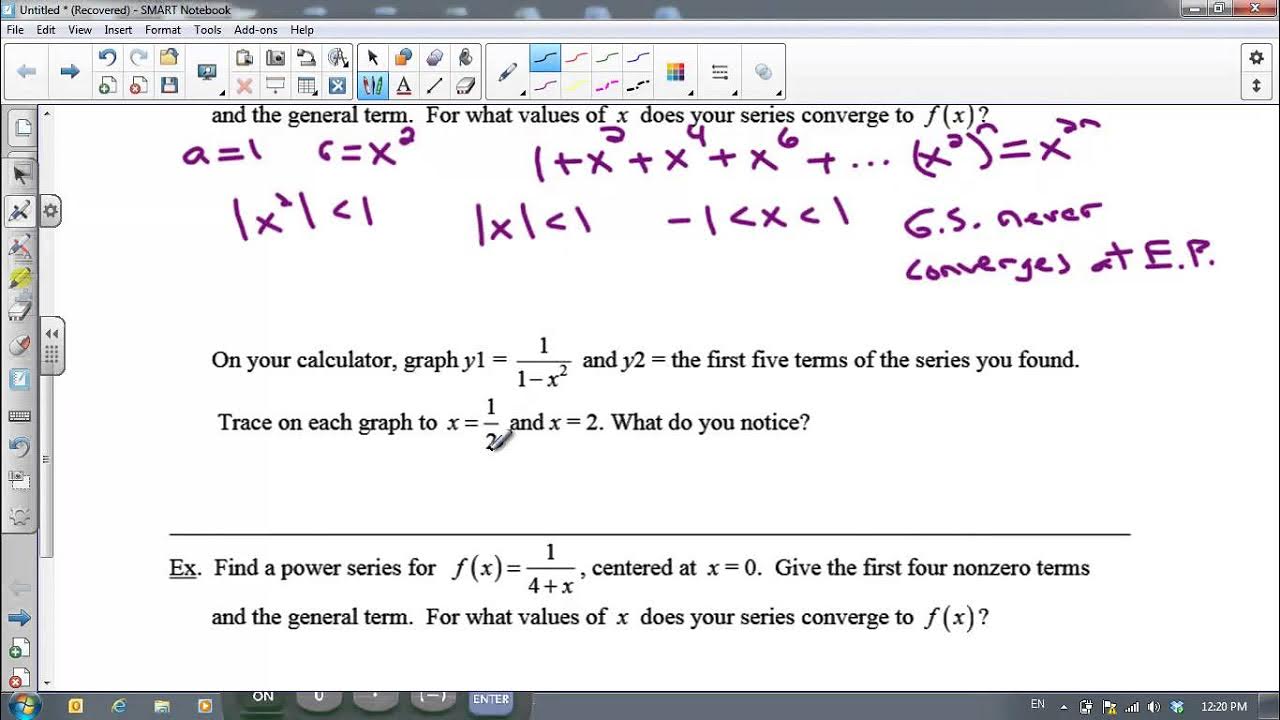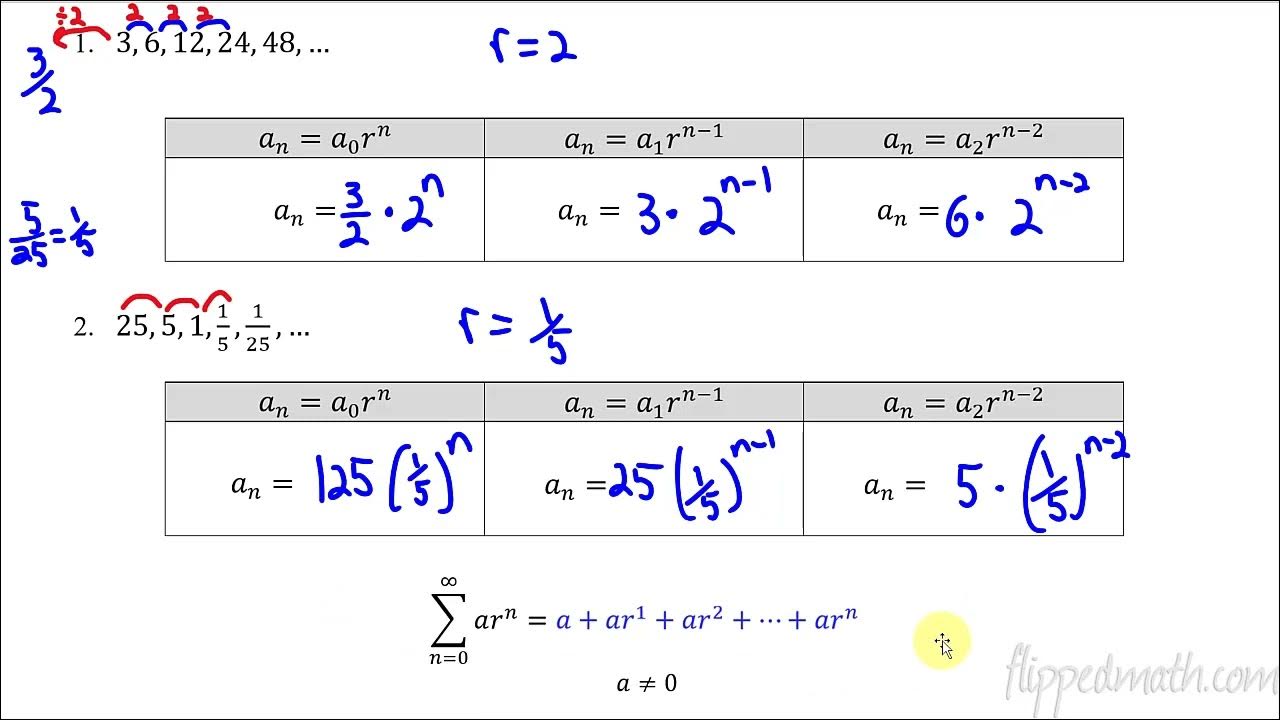Geometric Series Summing to Functions
TLDRThis educational video delves into the concept of geometric series, focusing on summing functions. It emphasizes the formula for the sum of an infinite geometric series, \( a \over 1 - r \), where \( |r| < 1 \). The presenter shares a preferred memorization technique and demonstrates the process with examples, including rewriting series and ensuring the ratio's absolute value is less than one. The video guides viewers through expanding functions into series, with attention to the interval of convergence, providing a clear understanding of geometric series applications.
Takeaways
- 📚 The formula for the sum of an infinite geometric series is \( a / (1 - r) \), where \( a \) is the first term and \( r \) is the common ratio, provided that \( |r| < 1 \).
- 🔍 A personal preference for memorizing the formula is the first term over \( 1 - \text{ratio} \), which is useful for series that start at a different point than \( n = 0 \).
- 📈 An example given is the series \( x^2 / (1 - 3x) \), which is rewritten to fit the geometric series formula by separating the base and exponent.
- 🔑 The importance of the condition \( |r| < 1 \) is emphasized for convergence of the series, with \( x \) needing to be less than \( 1/3 \) in the example provided.
- 📝 The series can be expanded by plugging in values of \( n \) to see the pattern and the general term, which is crucial for understanding its behavior.
- 📉 The interval of convergence is the set of values for \( x \) where the series converges, which is \( |x| < 1/3 \) in the first example.
- 🔄 The second example involves rewriting \( x / (4 + 6x) \) to fit the geometric series formula, emphasizing the manipulation of terms to identify the first term and ratio.
- 📌 The interval of convergence for the second example is \( |x| < 2/3 \), highlighting the need to check the absolute value of \( r \) for convergence.
- 🧩 A third example demonstrates how to construct a series by rewriting a function to resemble the sum of a geometric series, showing the process of term-by-term construction.
- 📐 The concept of interval of convergence is revisited, with the third example requiring \( |x^2| < 1/2 \), which translates to \( |x| < 1/\sqrt{2} \).
- 🛠️ The script concludes with a reminder of the practical applications of geometric series in summing functions and the importance of understanding their properties.
Q & A
What is the general form of a geometric series?
-The general form of a geometric series is the sum from 0 to infinity of a times r to the n, which can be rewritten as the sum of the first term (a) over 1 minus the ratio (r), provided that the absolute value of r is less than 1.
Why is it important to memorize the formula for the sum of a geometric series?
-It is important to memorize the formula because it allows you to quickly recognize and sum geometric series, which is essential for solving problems efficiently.
How can the expression x squared over 1 minus 3x be rewritten as a geometric series?
-The expression x squared over 1 minus 3x can be rewritten as the sum from 0 to infinity of x squared times (3x) to the nth power, which simplifies to the sum of 3 to the n times x to the n plus 2.
What is the interval of convergence for the series x squared over 1 minus 3x?
-The interval of convergence is the set of x values for which the series converges. For x squared over 1 minus 3x, the interval of convergence is the absolute value of x less than 1/3.
How can you transform the expression x over 4 plus 6x into a geometric series?
-You can divide everything by 4 to get x over 4 divided by 1 plus 3x over 2. Then, rewrite it as x over 4 divided by 1 minus negative 3x over 2, which identifies the ratio as negative 3x over 2.
What is the interval of convergence for the series x over 4 divided by 1 minus negative 3x over 2?
-The interval of convergence for this series is the absolute value of x less than 2/3.
How can you rewrite the series 2x cubed over 2 plus 4x squared to find its geometric series representation?
-Divide everything by 2 and rewrite the denominator as 1 minus negative 2x squared. Factor out x cubed to get x cubed times the series of 1 over 1 minus negative 2x squared.
What is the interval of convergence for the series 2x cubed over 2 plus 4x squared?
-The interval of convergence for this series is the absolute value of x less than the square root of 1/2, which simplifies to the absolute value of x less than 1 over the square root of 2.
How can you expand a geometric series to its general term?
-To expand a geometric series to its general term, start with the first term and repeatedly multiply by the ratio, writing out each term until you reach the general form, which includes the nth term and the interval of convergence.
Why is it helpful to write out the general term of a geometric series?
-Writing out the general term of a geometric series helps to clearly understand the structure of the series, determine its convergence, and solve related problems more effectively.
Outlines
🔢 Introduction to Geometric Series and Summation of Functions
This section introduces the topic of geometric series and the summation of functions. It explains the basic formula for the sum of a geometric series from 0 to infinity, \( a \cdot r^n \), and its simplified form, \( a / (1 - r) \), given that the absolute value of \( r \) is less than 1. The presenter emphasizes the importance of memorizing this formula and shares a personal preference for an alternative memorization method. An example involving \( x^2 / (1 - 3x) \) is provided, demonstrating the steps to rewrite the function as a geometric series, ensuring the absolute value condition for convergence is met.
🔄 Transforming and Summing Another Geometric Series
This paragraph discusses another example of transforming and summing a geometric series. The given function is \( x / (4 + 6x) \), which is not in the desired form. The presenter divides each term by 4 to achieve \( x / [4 \cdot (1 - 3x/2)] \). They then identify the ratio as \( -3x/2 \) and rewrite the series accordingly, simplifying the numerator and denominator. The interval of convergence is calculated, ensuring the absolute value of the ratio is less than 1, leading to the condition that \( |x| < 2/3 \).
🔄 Converting Functions to Geometric Series
This section explores a different approach to converting functions into geometric series. Starting with the known sum of \( x^n \) from 0 to infinity as \( 1 / (1 - x) \), the presenter manipulates a new function, \( 2x^3 / (2 + 4x^2) \), into a suitable form. By dividing everything by 2 and adjusting the denominator to a 1 minus form, the function becomes \( x^3 / (1 - (-2x^2)) \). The presenter demonstrates how to rewrite this as a series by replacing \( x \) with \( -2x^2 \), expanding term by term, and including the interval of convergence, which requires \( |x| < 1/\sqrt{2} \).
🔚 Conclusion and Final Example
In the concluding section, the presenter provides another example of transforming a function into a geometric series. They begin with a function, divide terms to standardize the denominator, and adjust signs to match the required form. The series is expanded term by term, ensuring the correct exponents and coefficients are applied. The interval of convergence is re-evaluated to confirm the validity of the transformation. The presenter summarizes the key points and methods discussed, emphasizing their utility in handling geometric series.
Mindmap
Keywords
💡Geometric Series
💡Summation
💡First Term
💡Ratio
💡Convergence
💡Infinite Series
💡Interval of Convergence
💡Rewriting
💡Absolute Value
💡Expansion
Highlights
The sum of an infinite geometric series can be expressed as the first term divided by 1 minus the ratio, provided the absolute value of the ratio is less than 1.
A preferred method to memorize the formula is the first term over 1 minus the ratio, which is flexible for series starting at different values.
An example is provided where the series is rewritten as a sum from 0 to infinity, with the first term and ratio clearly identified.
The importance of breaking down the product to a power into individual bases is emphasized for clarity.
The condition that the absolute value of the ratio must be less than 1 is crucial for the convergence of the series.
The example of x squared over 1 minus 3x is used to illustrate the process of rewriting and identifying the first term and ratio.
The series equivalent of the function is derived, and the domain of convergence is identified as the absolute value of x being less than 1/3.
The series is expanded to show the general term and the infinite progression, highlighting the importance of the domain.
Another example with x over 4 plus 6x is presented, demonstrating the process of rewriting the function into a recognizable geometric series form.
The technique of dividing by a common factor to simplify the series expression is shown.
The process of rewriting the ratio and identifying the first term is detailed for the series x over 4 minus 3x/2.
The importance of ensuring the absolute value of the ratio is less than 1 for convergence is reiterated, with the specific condition for x being less than 2/3.
A third example starts with a known sum of a geometric series and manipulates the function to match this form, allowing for series expansion.
The method of factoring out terms and replacing x with a specific expression in the series formula is demonstrated.
The process of term-by-term expansion to match the original function and its series equivalent is shown, emphasizing the construction of the series.
The final answer is presented, built term by term, demonstrating the practical application of geometric series in function analysis.
Transcripts
Browse More Related Video

Geometric Series (Precalculus - College Algebra 72)

Power series of ln(1+x_) | Series | AP Calculus BC | Khan Academy

Sum of an infinite geometric series | Sequences, series and induction | Precalculus | Khan Academy

Taylor Series Day 3

Calculus BC – 10.2 Working with Geometric Series

Another derivation of the sum of an infinite geometric series | Precalculus | Khan Academy
5.0 / 5 (0 votes)
Thanks for rating: